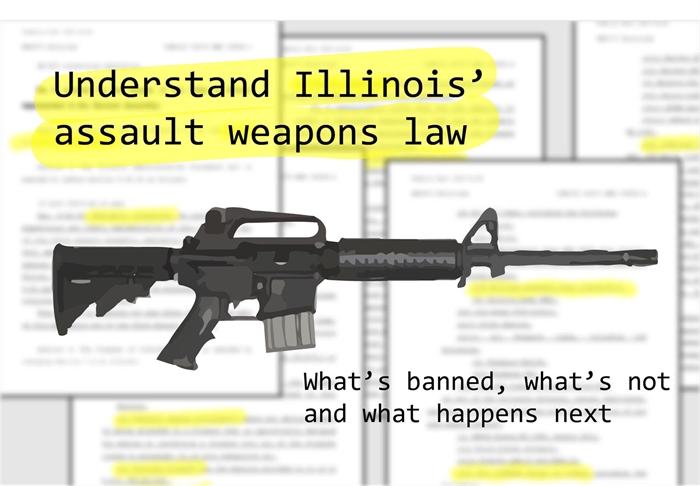What to know about Illinois’ assault weapons ban

Gun owners face a Jan. 1 deadline to register their assault weapons with the state under Illinois’ assault weapons law.
But between lawsuits and ongoing policymaking, the exact guns, accessories and ammunition covered under the Protect Illinois Communities Act remain unclear to many gun rights advocates, who point out that the ban includes some of the most popular models in the country.
The assault weapons ban went into effect when Gov. JB Pritzker signed it in January 2023, immediately prohibiting the sale in Illinois of a long list of weapons and attachments. But Illinoisans who own assault weapons – a term that is itself contentious among gun advocates – can keep them, so long as they purchased them before the law went into effect and register them with the Illinois State Police before the end of this year.
At the end of November, with four weeks before the deadline, nearly 4,900 individuals had filed disclosures with ISP. Owners of now-banned firearms, accessories and ammunition face criminal penalties if they fail to file that disclosure paperwork.
Which guns and accessories are affected?
Illinois’ assault weapons ban is wide-ranging and affects a variety of firearms and accessories, most notably weapons based on the design of the AR-15.
The law classifies more than 170 different models of firearm as assault weapons. The statute also lists several general types of weapons under its definition of assault weapon, including AK-type and AR-15-type rifles. It also lists AK-type, AR-type, MAC-type, Thompson-type and Uzi-type pistols. The act restricts IZHMASH Saiga 12-type shotguns. Rifles that shoot .50 caliber rounds are also regulated by the act.
But much of the confusion surrounding the law centers on the fact that it also restricts features that would classify an otherwise acceptable gun as an “assault weapon.” These include thumbhole, folding, telescoping and detachable stocks, pistol grips on rifles, flash suppressors, grenade launchers, barrel shrouds that allow users to hold the barrel without being burned, and the capacity to accept ammunition belts.
Accessories that would give an otherwise unregulated firearm one or more of these features are regulated as “assault weapon attachments,” and they also require a disclosure with state police.
Pistols are also restricted if they have a threaded barrel, a second grip, the capacity to accept magazines outside of the grip and shoulder stocks.
Revolving cylinder shotguns are restricted as well as semiautomatic shotguns that have the capacity to accept a detachable magazine or a fixed magazine with more than five rounds.
Importantly, any firearm that has been modified with aftermarket accessories to achieve the same effect as the state’s definition of “assault weapon” would still fall under the ban. This means that a collection of parts that could convert a firearm into an assault weapon – for example, an unregulated pistol and conversion kit – would be considered an assault weapon, even if the kit is unassembled.
The law also bans .50 caliber BMG rounds. While common, these are not the only type of .50 caliber ammunition. Owners of this type of ammunition must file a disclosure with state police.
Ammunition feeding devices are also regulated by the act, but in a slightly less strict fashion than weapons. The law bans “large capacity” magazines, which it defines as being 15 or more rounds for pistols and 10 or more rounds for rifles. While banned, owners of large capacity magazines do not need to file a disclosure.
Affected gun owners must file an affidavit or face criminal penalties
Owners of weapons regulated under the act can legally keep assault weapons, now-banned accessories and .50 caliber rifles, if they owned the weapon or accessory prior to Jan. 10, 2023, when the law went into effect, and they register them with ISP. Some people, notably law enforcement officers, are exempt from the disclosure requirement.
People required to file this paperwork, called an “endorsement affidavit,” can do so at the state police Firearms Services Bureau website. This is the same online portal used for concealed carry licenses and Firearm Owners Identification cards. These affidavits must be submitted electronically and submitting false information would be considered perjury.
These online disclosures require the maker, model, serial number and caliber of the gun. For accessories, a description and part number are required. A date of purchase is required if that information is available.
If a gun owner moves to Illinois from a state where they legally owned firearms or accessories banned under Illinois’ law, they must file an endorsement affidavit with the state police within 60 days of moving to Illinois.
This applies to owners of assault weapon attachments, even if they do not own an assault weapon. Local law enforcement agencies and the state police are responsible for enforcing the assault weapons ban in the same manner they currently enforce other regulations, such as the rules around FOID cards.
Read more: Sheriffs say they want no role in enforcing state’s assault weapon registry
Penalties for violating the law vary. Carrying or possessing an assault weapon is a Class A misdemeanor. This is generally punishable by up to a year in jail or a fine of up to $2,500. Manufacturing, selling, delivering and purchasing those weapons, however, is a Class 3 felony. These are generally punishable with five to 10 years in prison and fines of up to $25,000.
A second or subsequent possession charge is considered a Class 2 felony, which is generally punishable by three to seven years in prison and a fine of up to $25,000.
Manufacturing, possessing, selling or importing assault weapon accessories and kits is also considered a Class 2 felony. Specific cases may vary in their sentencing.
While the law bans the sale and possession of large-capacity magazines, owners do not need to file a disclosure if they had these magazines prior to Jan. 10, 2023.
For a brief period of six days this spring, an injunction temporarily halted enforcement of the assault weapons ban. Anyone who purchased a regulated weapon after Jan. 10, 2023, including during that window, is in violation of the law.

How many banned guns are there in Illinois?
As of Dec. 4, nearly 4,900 people had filed disclosures in accordance with the state’s assault weapons ban. They collectively filed about 9,300 weapons disclosures, about 4,800 accessory disclosures and 87 ammunition disclosures.
Estimating how many people own the types of guns outlined by the state’s assault weapons ban is nearly impossible, due to limited data collection requirements and inconsistent definitions of terms like “assault weapon” and “AR-15-style rifle.”
That said, some estimates do exist.
A survey conducted by Ipsos, a large market research firm, found that last year, one in five gun owners in the United States owned an AR-15 or similar gun. Estimates for gun ownership more broadly in Illinois vary, with research suggesting between 25 and 30 percent of the households in the state own a gun. Older data suggests closer to 20 percent.
Taken together, those statistics suggest that around hundreds of thousands of Illinoisans will be impacted by the state’s assault weapons ban.
Despite this uncertainty, the prevalence of these guns is one of the issues at the heart of the ongoing legal battle over the constitutionality of the law.
Arguments in the federal cases that could invalidate or uphold the law have repeatedly turned to whether the guns are in “common use.” Under recent U.S. Supreme Court rulings, guns in common use are generally protected under Second Amendment’s right to bear arms.
State officials still settling rules, implementation
As with many state laws, Illinois’ assault weapons ban has been the subject of administrative rulemaking, the process whereby the state agency responsible for implementing the law lays out the rules by which it will do so.
The state police have proposed rules that are now under consideration by an oversight committee of lawmakers. The rulemaking on the subject has been closely watched and has spun off into a series of dedicated hearings hosted by ISP to gather public input on how to execute the law.
Read more: State police still drafting assault weapons registration rules as deadline nears
One of the central issues at the heart of these hearings has been how precisely ISP will interpret some of the vaguer aspects of the law. This includes a final decision about exactly which items must be registered.
The law is also the subject of ongoing litigation. Several federal cases challenging the constitutionality of the law could be decided by the U.S. Supreme Court. Earlier this month, a three-judge panel on the 7th Circuit Court of Appeals issued a 2-1 opinion allowing the law to remain in effect while the cases continue.
Read more: Federal appeals court upholds Illinois’ assault weapons ban
This story will be updated as litigation and administrative rulemaking continues. See something incorrect or have a question that wasn’t answered here? Email aadams@capitolnewsillinois.com.
Capitol News Illinois is a nonprofit, nonpartisan news service covering state government. It is distributed to hundreds of print and broadcast outlets statewide. It is funded primarily by the Illinois Press Foundation and the Robert R. McCormick Foundation, along with major contributions from the Illinois Broadcasters Foundation and Southern Illinois Editorial Association.
Miss Clipping Out Stories to Save for Later?
Click the Purchase Story button below to order a print of this story. We will print it for you on matte photo paper to keep forever.

